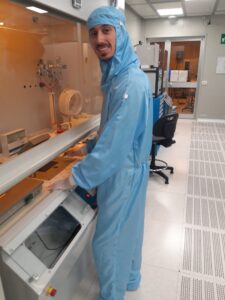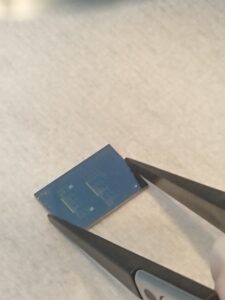Curious to learn more about GRAPH-X from one of the researchers involved? Postdoc Alex Boschi shares his perspective on the project
GRAPH-X is an exciting project with multiple facets – yet its complexity can also make it difficult for people outside of the project to understand the everyday work being done as part of it.
Happily, researchers across GRAPH-X are enthusiastic about their work and discussing it, which means that sometimes, in a spare moment between conducting experiments, writing papers, and exchanging ideas, they step out of the lab and into the interview chair! We spoke with Alex Boschi, a postdoctoral researcher in 2D materials engineering at the Italian Institute of Technology (IIT) in Pisa, to learn more about his work on the project.

Tell us a bit about your role at IIT and as part of GRAPH-X.
I am a postdoc at IIT in Camilla Coletti’s group. As well as being involved in GRAPH-X, we are also involved in other major pan-European projects such as the Graphene Flagship, in which we form part of Work Package 3 – Enabling Materials.
I have been in this group for the past 9 months. When I joined, research was related primarily to Graphene Flagship projects. I worked to produce cleaner interfaces and cleaner graphene through different approaches. Then I moved to working more on the GRAPH-X project, which meant my responsibilities shifted more from cleaning to assembling graphene and 2D materials one in on top of the other and manufacturing electronic devices.
Can you explain further what GRAPH-X work involves and how your research relates to the project?
The goal of the GRAPH-X project is quite challenging: ultimately, the project aims to create a device that mixes electrical and optical signals together to produce an output in sub-THz frequency domain. This domain can enable transmitting and detecting high volume of data (tens of Gbit per second) at short-distances and the mixer device could become a key component in 6G communication systems. Indeed, current technologies working at those frequencies have complex architectures and suffer of many drawbacks.
Our hope, however, is that the sub-THz mixer based on graphene help lower the number of devices needed for the mixing, while matching required performances and being readily integrable into existing circuits for telecom applications.
In terms of my research, I am currently investigating how using assemblies of 2D materials could help us in producing this mixed signal output. This involves sandwiching one or more layers of graphene in between two boron nitride layers in order to see whether this structure helps boost mixing performances.
Can you tell us more about what it is like working at IIT and in your specific group?
I really enjoy working here! There are many aspects of this particular research group and IIT more broadly that are really conducive to high-quality research and positive work environments.
For instance, I enjoy the collaborative aspect of our work. As part of GRAPH-X alone, for instance, we already collaborate with a range of interesting academic and industry partners – including the Leibniz Institute for High Performance Microelectronics, Nokia, and the University of Cambridge.
I also greatly appreciate the chance to be a part of Camilla Coletti’s group. It’s a group with strong research capabilities: one of the group’s strengths is characterising and synthesising graphene and other 2D materials on different substrates, for example, which have great potentialities in many electrical and optoelectronic applications.
At IIT, it is also possible to grow high-mobility graphene with techniques that are more scalable, and which can be implemented on pilot lines – this is rather unusual, and is something special about the work being done at IIT.
I also find doing research here to be a positive experience more broadly because IIT is well-resourced, runs efficiently, and has state-of-the-art facilities. I also enjoy being in this particular group because it is open to trying new things and really values the contributions of each member of the group. It’s a good place to be.

